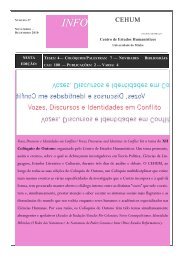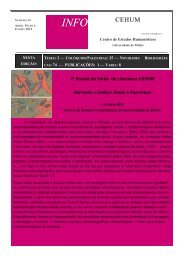Diacritica 25-2_Filosofia.indb - cehum - Universidade do Minho
Diacritica 25-2_Filosofia.indb - cehum - Universidade do Minho
Diacritica 25-2_Filosofia.indb - cehum - Universidade do Minho
You also want an ePaper? Increase the reach of your titles
YUMPU automatically turns print PDFs into web optimized ePapers that Google loves.
QUEEN CAROLINE AND THE PRINT CULTURE OF REGENCY RADICALISM<br />
seventeenth-century emblem books. [19] Th e vigilance of the free press (the<br />
radical press) equally protects the Queen and the people:<br />
Scorn’d, exiled, baffl ed, goaded in distress,<br />
She owes her safety to a fearless Press:<br />
With all the free<strong>do</strong>m that it makes its own,<br />
It guards, alike, the people and their throne; (181)<br />
173<br />
Th e celebration of the press was the theme that linked Hone’s satiric<br />
pamphlets. From the Political House to A Slap at Slop (Hone, 1822), his last<br />
satiric pamphlet, Hone celebrated the press as a force against tyranny and<br />
corruption. Played against an environment of restrictive press legislation,<br />
Hone’s use of the popularity of his satires to publicise the democratic role of<br />
the press displays the sense of mission of Regency radicals and constitutes a<br />
determined contribution to the establishment of a freer press and society.<br />
Th e ‘trial’ of the Queen provided a climatic moment of the satiric representation<br />
of the Aff air. Hone exploited the satiric potential of trial parody [20]<br />
in Non Mi Ricor<strong>do</strong>. Hone had already made use of trial parody in 1817,<br />
with the satire on Lord Castlereagh Another Ministerial Defeat! Th e Trial of<br />
the Dog for Biting the Noble Lord (Hone, 1817). In this satire, Lord Castlreagh’s<br />
<strong>do</strong>g, appropriately nicknamed ‘Honesty’, was tried for having bitten<br />
his lordship. [21]<br />
Non Mi Ricor<strong>do</strong>! was published in September 1820 during the proceedings<br />
against the Queen in the House of Lords, and went through at least<br />
thirty-one editions in 1820. Kent and Ewen (2002: 22) claim that the idea<br />
for Non Mi Riccor<strong>do</strong> came from conversations between Hone and Cruikshank,<br />
and probably Hazlitt, at the Southampton Coff ee House in Chancery<br />
Lane.<br />
In Non Mi Ricor<strong>do</strong>, George IV is ridiculed in an imagined cross-examination<br />
at the Queen’s trial. Hone exploits the stylistic confrontation between<br />
Majocchi, (the Italian witness discredited by Henry Brougham, one of the<br />
Queen’s attorneys) and George IV in a discursive ‘decomposition’ (Marsh,<br />
19 Cruikshank’s design alludes directly to the print Th e Double Deliverance, of 1621 by the Ipswich<br />
preacher Samuel Ward (Dunan-Page and Lynch, 2008).<br />
20 Other trial parodies include Th omas Wooler’s ‘Trial Extraordinary’ and ‘Th e State Trials Contrasted<br />
with the Manchester no Trials’. During the proceedings against the Queen several other<br />
trial parodies of imagined cross-examinations of the King appeared, namely Examination<br />
Extraordinaire of the Vice R–y of B–d–yboro! Alias Th e Handsome Gentleman (Anon., 1820).<br />
21 Animal trials were very popular trial parodies in the early nineteenth-century. For some examples<br />
of animal trials, see Wood (1994: 145-7).<br />
<strong>Diacritica</strong> <strong>25</strong>-2_<strong>Filosofia</strong>.<strong>indb</strong> 173 05-01-2012 09:38:28



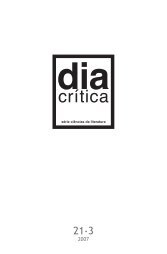

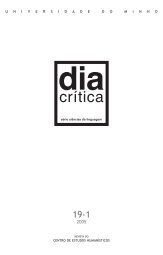



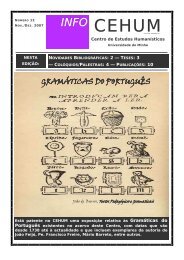

![Programa [pdf] - cehum - Universidade do Minho](https://img.yumpu.com/17305425/1/190x135/programa-pdf-cehum-universidade-do-minho.jpg?quality=85)


